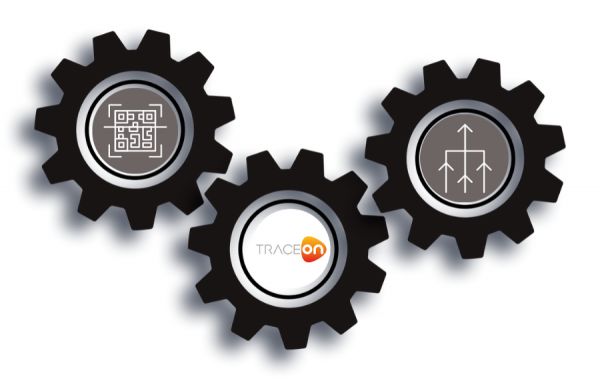In Poland the need to increase supervision over the production process emerged in 2002 together with Regulation (EC) No. 178/2002 of the European Parliament and of the Council taking effect. Since then, it has been continually gaining importance. To which manufacturers does traceability apply? What difficulties may it be able to solve?
Traceability in production and supply chain
At first, let us look closely at a production process of any plant. It is very rare for products to be manufactured only in one facility, without any contractors, freight forwarding companies, etc. The manufacturer starts from purchasing plant seeds which then he puts through successive stages of growth. He matches temperature, insolation, humidity, soil composition and other conditions to the individual need of seedlings depending of their stage of growth. Additionally, the manufacturer uses special technology and chemical substances in order to accelerate growth and provide pest control. When plants reach the expected stage of development they are transported to other manufacturers. Those in turn apply their own technology, substances and transport to further destinations. Finally, the products reach supermarket shelves and their journey ends in clients’ carts.
Situation presented above seemingly does not generate difficulties until the product proves to be faulty, damaged in transport or to contain noxious compounds. In that event, it is very hard to trace when and by whom the procedural rules have been breached. The distributor is then unable to identify the member of production chain responsible for clients’ discontent.
Tracing weak spots
Let’s investigate a single example:
A supermarket orders a batch of strawberries. Manufacturer responsible for cultivation orders in turn a number of seedlings. In addition, each contractor purchases substances and other components that are essential in terms of growing and plant protection. All mentioned facilities are connected with freight forwarding companies. At times, ordered fruit happen to go off before they reach the supermarket. Who is responsible for the profit loss then? The distributor usually forces his immediate supplier to pay the consequences, but maybe the latter is not actually responsible? It may be hard to prove who is guilty in this case if the whole chain of production does not have a proper product monitoring implemented. Maybe the strawberries were stored improperly during transportation? Maybe the manufacturer sent them to the distributor too late? Or maybe some unusual technology has been applied in the whole process which led to early rotting?
Quality control
Lots of manufacturers tend to ask themselves the same questions when they suffer the financial or legal consequences of an unsuccessful cooperation. Most of them probably supervise the procedures applied in their enterprises and take good care of product quality. It is however not always enough to prevent the company against employee negligence or errors made by other members of production and transportation chain.
Even more difficulties may emerge if dangerous chemical substances are present in production processes. It, above all, concerns artificial crop protection products and pharmaceuticals. Chemical composition of products is always subject to rigorous control in terms of noxious compounds. Controlling institutions’ policy is to either impose permissible concentration level or completely ban the use of some substances.
Traceability in a nutshell
The problems above are tightly connected with traceability of products. In practice, traceability means marking chosen batches of goods with proper codes and keeping record of actions and events during production processes. In case of any inspection the manufacturer is able to demonstrate company’s performance as well as the implemented technology. Therefore, traceability is a very important factor influencing the credibility and reputation of the enterprise. The same method proves that surveillance system has been implemented in the company with due diligence. Traceability also makes external control possible: retracing the history of semi-finished products or their way to the distributor is easier than ever.
Methods becoming obsolete
A great number of manufacturers consider rules introduced by EU Parliament as unduly demanding and decide not to implement new solutions. Some Polish companies still run only paper records – the method is regarded cheap, but less and less efficient. However, keeping such records usually requires huge work and time input, which in turn usually results in employing a new worker. Costs increase with no measureable profits from product register. The problem grows deeper in case of an inspection the need to present the documentation to the controlling institution. The process of record revival usually takes from a couple of hours to a couple of days which naturally impedes the work of both controlling and controlled party.
Close cooperation with suppliers and distributors as well as mutual trust become impossible for those who still use paper records. Transparency and efficient communication are in this case fundamental factors. Without the ability to send information quickly (often to a very far destination) it is impossible to achieve a proper level of integration inside the whole production process chain. What is more, huge distributors (e.g. hypermarkets) put high pressure on modern solutions and implement very rigorous quality norms. Supplier which keeps records of their products in paper notebooks appears to those distributors as old-fashioned and untrustworthy.
Is the future encoded?
Marking the products with barcodes proves to be a little better method of identification. This code of conduct is widely spread and well-known, however might not be efficient enough to meet all the contemporary market’s needs. A barcode carries a very limited (as for our reality) amount of data with poor identification capability. One might encode max. 128 signs, however the limit of 43 signs is more usual. The initial idea of barcodes was connecting one product with the whole tranche and price identification.
These days, apart from features listed above, providing specific information about products becomes more and more important. Data is narrowed down to the smallest unit possible, e.g. one pallet. The sole idea of traceability assumes maximally detailed monitoring of production process, therefore a bigger amount of signs is needed to describe given products. Thus, increasing popularity of QR codes enabling the aforementioned description with 7089 numeric or 4296 alphanumeric signs.
Modern consumer, modern company
Why does the sudden need to implement traceability in production processes come from? Why are traditional methods considered inefficient? The aforementioned Regulation (EC) No. 178/2002 partly answers these questions – this is just how the law works. However the law is also subject to and effect of economy changes as well as new customer mentality.
Nowadays the production process is less and less limited to one company and few manufacturers deal with creating from scratch. Production chains with many contributors prove to be the most popular. Such an approach leads to diffusion of responsibility in terms of the final product which in turn decreases the level of control. Let us assume that a market gardener produces carrots independently: grows them, distributes, uses his own seeds, seedlings, fertilizers, transport and storage techniques. In this case the quality of vegetables rests only on the gardener. This “farm-to-table” production model becomes obsolete though and this is why a very close cooperation between production contributors is crucial.
Consumers’ point of view is also very important since they are aware of economic changes and well-informed about their rights. They receive frequent news about noxious substances found in products. Such information spreads quickly and globally which might lead to almost immediate bankruptcy. That is why traceability becomes more and more appreciated method of gaining distributors and customers’ trust since it enables quick access to the source of potential problems. An instant product deletion saves all production chain contributors from negative financial and marketing consequences. All in all, consumers feel safe and producing parties do not risk their reputation.
Beginnings are always hard
Implementation of traceability is not easy though. The efficiency of systems usually depends on all production chain contributors’ engagement. They must work out proper cooperation and fluent flow of data. Each company being such a contributor must deploy an efficient production and service monitoring system. Through that, it will be able to defend itself in case of deficient product detection.
How should one introduce traceability in their company then? Firstly, take care of your “home ground”. Consider how precisely you monitor processes of your company. Try to detect potential loopholes. Ask employees working in different divisions and on different posts – you may conduct an anonymous survey. Next, think about a way in which you process and store data – is it up-to-date or rather obsolete? Another good move might be an audit carried out by an IT company. Experts are able to advise further steps and tell you what to implement in order to gain maximal control over production. One good example of such IT solutions might be Traceability system created by specialists. https://www.korsol.pl/en/our-ideas/traceability
Your own „link” is already under control. Now it is time to take care of the whole chain: get in touch with your suppliers, consignees, logistic services that are your partners. Ask them about the way they control production and product quality. It is also advisable to recommend them your IT specialists and traceability implementation method. Using the same solutions leads to consistency and transparency which are important factors supporting traceability. The whole implementation process might take some time, although one should not get discouraged having in mind future profits.
Prospective benefits
Lengths taken in order to introduce traceability in every production stage lead to diversity of profits. Manufacturers focus on taking care of their own products or services, however their collective efforts increase the quality and reputation of the final product. As a consequence, they gain a group of satisfied customers, avoid financial loss due to faulty product release and meet the conditions imposed by the EU. That way, initial investment in IT systems and equipment brings long-lasting benefits on different levels of company management. Even if you do not deal with food or medical industry, traceability is worth investing in, because it gives control, save your time and provide valuable equilibrium.






